
This photograph of a gas mask on a tree beside a track in Kreminna in Ukraine’s Luhansk oblast stopped me in my tracks.
The original caption in the Guardian reads “tree” but it looks like the remains of a tree, more like a planted post. Has the rest of it – the parts that make it a tree – been damaged by war? Whatever the explanation there is a hint, in the mottled pattern of the bark, of a giraffe’s neck, that vulnerable loneliness of the vertical amid the overwhelmingly horizontal. By a careful choice of angle the photographer has also imparted an animating slinkiness, a slightly feminine torsion, to the immobile wood. That might be why it’s reminiscent of one of Peter Mitchell’s wonderful photographs of scarecrows in Yorkshire. The one I have in mind is a rare example of what is obviously a woman plying this exposed and elemental trade, glamorously kitted out for a night – she is framed by darkness – on a nonexistent town. Lifelike and haunted, she looks like a ghost of her former self.
Despite Annie Dillard’s bold insistence – “I never saw a tree that was no tree in particular” – for many of us, trees are just generic trees. In its uncanny way the gas mask humanises this tree in Ukraine, lending it an identity that is contrary to what happens whenever a human is obliged to wear one. Everyone, man or woman, attractive or unattractive, ends up looking the same. What we have here, then, is a highly individualised form of anonymity that is in keeping with one of the most solemnly familiar species of war memorialisation: the unknown warrior. This was instituted in Britain in 1920 in the stunned aftermath of the first world war during which time the experience of the warrior had begun to acquire a quality of passivity. By the end of the second world war combatants and civilians alike shared the helpless experience of enduring bombardment, either from the air, by planes or by land from artillery. So the unknown figure of the wars of the 20th century and, of course, those now under way in Ukraine and Gaza, might well be the unknown non-combatant. Through no fault of their own, men, women and children become caught up in something dreadful, as might happen to a tree. A further layer of anonymity or unknown-ness is provided by the caption which identifies the agency but not the photographer who actually took this remarkable picture.
Another twist is provided by the way that spring is pleasantly in the air. This would be a nice track to hike along, on which to assert one’s right to roam. There is none of the devastation seen on such a massive scale in German cities after the second world war that saw some of the allied commanders who had ordered the bombing campaign shocked at the thoroughness of what had been achieved. The gas mask expresses a more insidious threat because it’s invisible. The landscape can remain attractive, bucolic, innocent, but the air – beauty itself – can be toxic. And if bombing imposed a shared passivity on soldiers and civilians alike, sudden changes in wind direction meant that poison gas – as happened at Loos during Britain’s first use of the new weapon in September 1915 – left those who had unleashed it as exposed as the enemies who were its intended target. The gas mask becomes a warning to everyone.
In this respect the assemblage – gas mask and tree – is obviously more wide-ranging in effect than the ghastly, makeshift effigy of Hitler assembled and planted by partisans in the middle of a track in Elem Klimov’s devastating film about the 1941 German invasion of Belarus, Come and See.
This act of provocation and resistance unleashes the atrocious mathematics of reprisal. While the photo of gas mask and tree was used to illustrate a news story on Russian use of poison gas it does not accuse or provoke Putin. It’s not even clear whether it was constructed with a purpose in mind or if it might be an example of the kind of found objects photographed by Henrik Saxgren in his series Unintended Sculptures. But the resulting photographs – both this one and those by Saxgren – bestow on such objects an aesthetic purpose felt more powerfully by virtue of being retrospective. A related temporal blurring is at work here. The photo becomes not only a memorial for what has already happened but a prophecy of what might be in store.